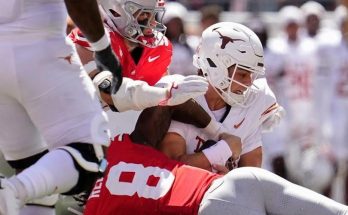The Kansas City Chiefs have done it again. In a bold yet calculated move to protect their most valuable asset, quarterback Patrick Mahomes, the franchise signed right guard Trey Smith to a massive four-year, \$94 million contract extension with \$70 million guaranteed—setting a new benchmark for interior offensive linemen across the league. But as fans, analysts, and insiders celebrated the well-deserved payday for Smith, a sobering reality emerged that may alter the offensive line’s configuration in the near future: Jawaan Taylor, the team’s current starting right tackle, is almost certainly playing his final season in Kansas City.
While the Chiefs front office, led by general manager Brett Veach, has never shied away from making unpopular decisions to protect long-term success, this one appears inevitable. Taylor, signed just last offseason to a four-year, \$80 million deal with \$60 million guaranteed, was expected to anchor the tackle position for years. However, his uneven performance, hefty price tag, and now redundant cost with Smith’s record-breaking contract all point to a likely release after the 2025 season. And as complex as this situation may seem on the surface, it’s actually a perfect case study in NFL economics, player development philosophy, and roster management strategy in a salary cap era defined by quarterback-driven dynasties.
Let’s begin with the economics. The Chiefs now have more than \$200 million committed to their offensive line over the next three seasons. Smith’s \$23.5 million average annual value makes him the highest-paid guard in the league. Center Creed Humphrey, also recently extended, earns \$18 million per year. Add in left tackle Jaylon Moore, brought in this offseason, and first-round pick Kingsley Suamataia, who may eventually start at right tackle, and you’ve got an expensive and crowded offensive line room. Meanwhile, Jawaan Taylor still carries a cap hit of nearly \$24 million in 2025, and \$27 million in 2026, with only marginal guarantees left on the backend of his contract. Financially, it doesn’t make sense to retain a right tackle at top-10 money when your right guard and center are already at the top of the market.
Even more crucial is Taylor’s on-field performance. Signed away from Jacksonville in 2023, Taylor was expected to make the leap from promising starter to elite edge protector. Instead, he struggled with consistency, committing a league-high 19 penalties in 2023 and giving up seven sacks in 2024—both career worsts. The Chiefs coaching staff, notably offensive line coach Andy Heck and offensive coordinator Matt Nagy, spent considerable time adjusting his stance and technique. Still, his performance was a step below the franchise’s expectations for someone earning over \$20 million annually. Taylor is by no means a bad player—he’s a solid starter in today’s NFL—but for a team looking to maximize every dollar in the Mahomes era, “solid” isn’t always enough.
Trey Smith, on the other hand, represents everything the Chiefs hope to build around. A sixth-round pick in 2021 due to medical concerns surrounding blood clots, Smith immediately earned a starting role and never looked back. He’s missed just one game in four seasons, has a Pro Bowl appearance under his belt, and is widely regarded as one of the strongest and most technically refined guards in football. Smith is a team captain, a locker room leader, and a crucial voice on an offensive unit that thrives on cohesion. By extending Smith, the Chiefs aren’t just paying for past production—they’re doubling down on culture, continuity, and championship-caliber trenches.
The move also signals a shift in the Chiefs’ philosophy regarding their offensive line investment. While in the early Mahomes years the team prioritized explosive offensive weapons, culminating in contracts for Tyreek Hill and Travis Kelce, the last few seasons have made it clear that protecting Mahomes is priority number one. This began in earnest after the disastrous Super Bowl LV performance, when Mahomes was sacked three times and pressured on over 50 percent of his dropbacks in a loss to the Tampa Bay Buccaneers. That moment prompted Kansas City to completely overhaul its offensive line, bringing in players like Joe Thuney (now traded), Orlando Brown Jr. (now with the Bengals), and eventually Taylor.
But success isn’t about flashy signings—it’s about sustained performance, alignment with the team’s identity, and wise cap management. Jawaan Taylor’s deal was frontloaded, giving Kansas City an easy out after two seasons, and that out is now looming large. By cutting Taylor after the 2025 season, the Chiefs would save nearly \$15 million in cap space in 2026, even after absorbing the dead cap hit. And with Suamataia likely ready to step in at tackle and Moore holding down the left side, the front office seems to have already prepared for life after Taylor.
There’s also the matter of priorities. The Chiefs must consider extensions for All-Pro cornerback Trent McDuffie, linebacker Nick Bolton, and eventually young receivers like Rashee Rice. While Kansas City doesn’t typically invest heavily in skill positions, they do take care of elite defenders and core offensive contributors. Choosing between Taylor and someone like McDuffie or Bolton won’t be difficult when the performance and positional value tilt in the defenders’ favor.
Moreover, the Chiefs’ offensive line pipeline has become one of the best in football. Year after year, Kansas City finds value in the draft—Creed Humphrey was a second-rounder, Smith a sixth-round steal, and now Suamataia and Josh Simmons represent the next wave of potential starters. They’ve built a system that develops offensive linemen better than almost any team in the league, giving them the freedom to let overpriced veterans walk without missing a beat. It’s a testament to coaching, scouting, and the organizational belief in long-term planning over reactive spending.
Taylor’s fate also reflects the cutthroat reality of the NFL. Contracts are rarely what they seem, especially in a cap-constrained environment. When Taylor signed in 2023, his deal was hailed as a paradigm shift for right tackles, signaling the end of position-based pay scales. Yet only two years later, that contract has become expendable, a placeholder until the next wave of younger, cheaper talent matures. This isn’t a failure of scouting or negotiation—it’s how the Chiefs remain competitive. They pay big when it matters, cut losses quickly, and continually evolve the roster.
It’s important to recognize that this potential parting of ways doesn’t necessarily reflect poorly on Taylor as a person or even as a player. He has been a professional, a locker-room presence, and a starter in multiple playoff runs. But the NFL is a production-based league. And when Trey Smith is dominating on the interior, Creed Humphrey is controlling the line of scrimmage, and Suamataia shows flashes of elite talent at a fraction of the cost, the writing is on the wall.
Even Taylor himself likely knows this. With minimal guarantees remaining and a first-round tackle waiting in the wings, the best-case scenario for him is to have a career year in 2025 and either restructure to remain with the team on a lower salary or hit free agency and cash in elsewhere. Either outcome requires elite performance, and that’s exactly what the Chiefs hope to get from him this year. He still has the opportunity to play meaningful football, to protect the best quarterback on the planet, and to contribute to a potential dynasty-cementing season. That’s more than many players can ask for.
The 2025 season is shaping up to be a pivotal one for the Chiefs. With Mahomes in his prime, Kelce entering the twilight of his career, and a rebuilt defense loaded with speed and youth, Kansas City is once again a Super Bowl favorite. But the foundation of that championship push lies in the trenches, and by committing long-term to Trey Smith, the Chiefs are saying loud and clear: we’ll win from the inside out. Jawaan Taylor’s tenure, while impactful, looks increasingly like a bridge to that future.
Fans should enjoy watching Taylor this season, because barring a seismic shift in performance or injury elsewhere on the line, this will likely be his swan song in red and gold. It’s a tough reality, but one that underlines just how cutthroat and calculated success in the NFL must be. The Chiefs are not sentiment-driven; they’re dynasty-driven. Every dollar, every snap, every decision revolves around keeping the Mahomes window wide open.
And if that means paying Trey Smith to set the standard while letting Taylor walk away just two years into an \$80 million deal, then so be it. This is the cost of greatness. This is the Chiefs’ way.



